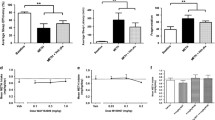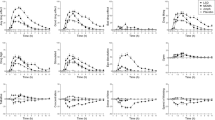Summary
Twenty Ss received, double blind, either a 15-mg dextroamphetamine sulfate (DA) spansule and pentobarbital (PB) 100 mg p.o. before bed on two nights or PB and a placebo (PL) on two other nights, all a week apart, in a balanced design. Fifteen of the Ss received DA and PB placebos on two additional nights. EEG and EOG recordings were obtained over a six-hour observation period on all nights.
DA + PB produced more body movements, spontaneous awakenings and stage-2 sleep and less delta sleep (stages 3 + 4) than did PB, while PB reduced time to sleep onset and produced less body movements and spontaneous awakenings than did PL. These findings were thought to indicate that DA decreases “soundness” and “depth” of sleep while PB increases them.
A decrease in emergent stage-1 sleep (activated sleep, AS) over the six-hour observation period with DA + PB was made up for by a corresponding increase in wakefulness (stage 0), while a decrease both in AS and stage 0 with PB was compensated for by a corresponding increase in nonactivated sleep (NAS).
Both DA + PB reduced per cent AS sleep time and first AS period (ASP) latencies, DA + PB more markedly than PB. DA appeared to produce this effect primarily by increasing first ASP latencies, while PB did so as well by shortening the first two ASPs.
The tendency of PB to reduce rapid eye-movement (REM) density within ASPs (DA did not do so), to produce periods of emergent stage 1 without REMs, to shorten ASPs without changing the intervals between successive ASPs and to produce a maximum in the concentration of body movements in the 60–90 min interval after sleep onset suggested that it does not induce a basic alteration in the sleep cycle but rather suppresses certain manifestations of the first ASP (REMs and stage-1 sleep), while leaving others, such as body movements, unchanged to persist as a “REM-period residue.” Since DA was always administered with PB, it is not clear by what mechanisms the former delayed the appearance of first ASPs.
Similar content being viewed by others
References
Aserinsky, E., and N. Kleitman: Regularly occurring periods of eye motility, and concurrent phenomena, during sleep. Science 118, 273–274 (1953).
Baekeland, F.: The effect of methyl phenidate on the sleep cycle in man. Psychopharmacologia (Berl.) 10, 179–183 (1966).
Coleman, P. D., F. E. Gray, and K. Watanabe: EEG amplitude and reaction time during sleep. J. appl. Physiol. 14, 397–400 (1959).
Dement, W., and C. Fisher: Experimental interference with the sleep cycle. Canad. Psychiat. Ass. J. 8, 395–400 (1963).
Fisher, C.: Psychoanalytic implications of recent research on sleep and dreaming. I. Empirical findings. J. Amer. psychoanal. Ass. 13, 197–270 (1965).
J. Gross, and B. A. Byrne: Dissociation of penile erection from REMP and rebound effect. Paper presented at the Ass. for the Psychophysiological Study of Sleep (APSS), Gainesville, Fla. (March, 1966).
— — and J. Zuch: A cycle of penile erection synchronous with dreaming (REM) sleep: Preliminary report. Arch. gen. Psychiat. 12, 29–45 (1965).
Foulkes, D.: The Psychology of Sleep. New York: Scribner's 1966.
Goodenough, D. R., H. B. Lewis, A. Shapiro, L. Jaret, and I. Sleser: Dream reporting following abrupt and gradual awakenings from different types of sleep. J. pers. soc. Psychol. 2, 170–179 (1965).
—, A. Shapiro, M. Holden, and L. Steinschriber: A comparison of “dreamers” and “nondreamers”: Eye movements, electroencephalograms, and the recall of dreams. J. abnorm. soc. Psychol. 59, 295–302 (1959).
Hartmann, E. L.: The D-state, a review and discussion of studies on the physiologic state concomitant with dreaming. New Engl. J. Med. 273, 30–35, 87–92 (1965).
Karacan, I., and D. R. Goodenough: REM deprivation in relation to erection cycle during sleep in young adults. Paper presented to APSS, Gainesville, Fla. (March, 1966).
Lester, B. K., and R. Guerrero-Figueroa: Effects of some drugs on electroencephalographic fast activity and dream time. Psychophysiology 2, 224–236 (1966).
Jouvet, M.: Paradoxical sleep—a study of its nature and mechanisms. In K. Akert et al. (Eds.): Progress in brain research, vol. 18, pp. 120–157. Amsterdam: Elsevier 1965.
Mandell, A. J., and M. P. Mandell: Biochemical aspects of rapid eye movement sleep. Amer. J. Psychiat. 122, 391–401 (1965).
Monroe, L.: Psychological and physiological differences between good and poor sleepers. Univ. of Chicago, unpublished Ph. D. thesis (1965).
Okuma, T., K. Nakamura, A. Hayashi, and M. Fugimori: Psychophysiological study on the depth of sleep in normal human subjects. Electroenceph. clin. Neurophysiol. 21, 140–147 (1966).
Oswald, I., R. J. Berger, R. A. Jaramillo, K. M. G. Keddie, P. D. Olley, and G. B. Plunkett: Melancholia and barbiturates: A controlled EEG, body and eye movement study of sleep. Brit. J. Psychiat. 109, 66–78 (1963).
Oswald, I., A. M. Taylor, and M. Treisman: Discriminative responses to stimulation during human sleep. Brain 83, 440–453 (1960).
Rechtschaffen, A., and L. Maron: The effect of amphetamine on the sleep cycle. Electroenceph. clin. Neurophysiol. 16, 438–445 (1964).
Shapiro, A.: REM time, dream time and amount of dreaming. Paper presented at APSS, Gainesville, Fla. (March, 1966).
Snyder, F.: Progress in the new biology of dreaming. Amer. J. Psychiat. 122, 377–391 (1965).
Williams, H. L., J. T. Hammack, R. L. Daly, W. C. Dement, and A. Lubin: Responses to auditory stimulation, sleep loss and the EEG stages of sleep. Electroenceph. clin. Neurophysiol. 16, 269–279 (1964).
Zung, W. W. K., and W. P. Wilson: Response to auditory stimulation during sleep. Arch. gen. Psychiat. 4, 548–552 (1961).
Author information
Authors and Affiliations
Additional information
This study was supported by grants from the National Institutes of Health, United States Public Health Service, nos. MH-23,901, MH-10088 and MH-7336.
This paper is based in part on a thesis submitted to the Department of Psychiatry, Graduate Educational Program, State University of New York, Downstate Medical Center, Brooklyn, New York, in partial fulfillment of the requirements for the degree of Doctor of Medical Science.
Drs. Donald R. Goodenough and Arthur Shapiro gave helpful advice in both the design of this experiment and the data analysis.
Abbott Laboratories provided the pentobarbital (Nembutal) placebos, and Smith, Kline and French Laboratories furnished the dextroamphetamine sulfate (Dexedrine) placebos.
Rights and permissions
About this article
Cite this article
Baekeland, F. Pentobarbital and dextroamphetamine sulfate: Effects on the sleep cycle in man. Psychopharmacologia 11, 388–396 (1967). https://doi.org/10.1007/BF00405022
Received:
Issue Date:
DOI: https://doi.org/10.1007/BF00405022




